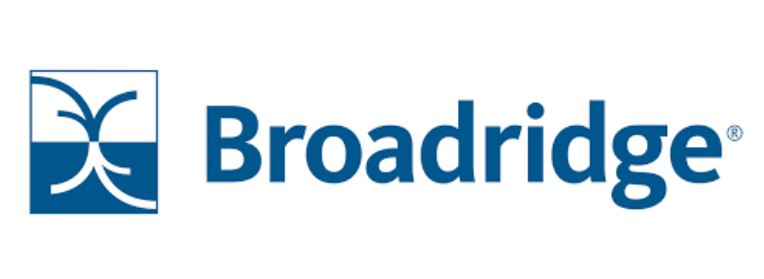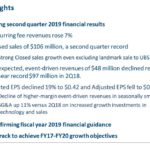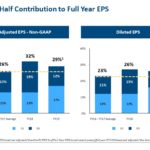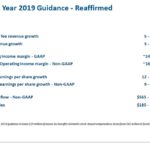Contents
Summary
- BR’s shares were grossly overvalued in August/September 2018 and the share price has subsequently retraced by just over 30% from the 52 week high.
- Q2 2019 and 1H 2019 results were released February 7th and the share price took a ~6.7% hit from the previous day’s close.
- The vast majority of investors make investment decisions without looking into the underlying reason why quarterly results have not met street consensus.
- The company is still on track to meet FY2019 targets and management has reaffirmed full year guidance.
- ~70% of full year earnings is generated in the second half.
Introduction
In recent articles I have indicated that I am of the opinion that within the short-term we can likely expect overall market weakness with pullbacks becoming increasingly probable or at the very least sideways price action.
I have written a few articles in which I have disclosed that I have written short-term out-of-the-money covered calls where I am of the opinion that a company’s share price is likely to pullback or likely to trade in a narrow range in the short-term. My most recent such article was on Becton Dickinson.
In other cases, a company releases earnings and Mr. Market comes to the quick conclusion that all is not well with the company and promptly punts the company to the curb. In these cases I like to step in and acquire beaten up shares in great companies. I disclosed a recent example of this in my February 5th Church & Dwight (CHD) article.
Here we are on February 7th and Broadridge Financial Solutions’ (BR) share price has pulled back following the release of Q2 and 1H 2019 results. Before the conference call was even held to discuss results the shares had tanked to ~$94 from the previous day’s close of $103.54!
As a BR investor from the day it was spun off from Automatic Data Processing (ADP) in 2007 I have closely followed the company over the years. I have written articles in which I have recommended BR and others in which I have recommend investors hold off on acquiring shares. In essence, I am not trying to flog BR. In fact, in my July 16, 2018 article for subscribers I indicated that Sometimes You Just Have to be Patient. as I viewed BR shares to be richly valued.
I followed up that article with this August 7, 2018 article for subscribers in which I concluded with:
‘I think Mr. Market has bid up the price to a level where perfection is expected. At some stage, I envision BR will retrace to a more reasonable valuation; I do not expect BR to retrace to a PE in the teens but somewhere between the low – mid 20s seems more reasonable.
As much as I like the company I just can’t bring myself to acquire more shares at this stage.’
By the time I wrote my November 6, 2018 article, BR’s share price had retraced from its lofty valuation of the summer of 2018 to the point where I suggested investors give a very serious look at acquiring BR shares since they had become more fairly valued; BR’s share price had retraced to ~$105 from its ~$138 high.
Subsequent to that November article, BR’s share price got caught up in the broad market pullback in December and retraced further to the ~$91.80 level on December 24th. The share price, however, quickly retraced to the ~$103.50 level by early February.
Now that I have had a chance to review the February 7th Q2 and 1H 2019 earnings release and earnings presentation and to read the transcript of management’s call with analysts I am taking this opportunity to revisit BR.
While it certainly is nice to know that BR has very recently been named to Fortune Magazine’s list of the World’s Most Admired Companies in the category of financial data services for the 6th time and that for the first time it has received the top ranking in the financial data services category, I am more of a ‘show me the money’ type of investor.
Before I look at BR’s results, guidance, and valuation I draw to your attention the company’s 3 key areas of focus.
- Deliver on FY2019 guidance and FY2020 objectives that were laid out at BR’s last Investor Day held in December 2017;
- Execute against Investor Day growth plans across Governance, Capital Markets, and Wealth Management;
- Build on current capabilities like culture, product, and technology.
Q2 2019 Results
BR’s Q2 2019 earnings release can be accessed here and its 10-Q can be found here.
Despite what initially appears to be weaker results, BR’s results are actually on target with previously provided guidance.
In Q2 BR notched record sales and strong recurring revenue growth.
Source: BR – Q2 and 1H FY2019 Earnings Presentation – February 7, 2019
Although EPS was lower than last year it was aligned with expectations, with strong recurring revenue growth in Q2 powered by exceptional growth in the Investor Communication Solutions (ICS) business.
Q2 adjusted EPS fell 29% as a result of the impact of lower event-driven revenue and higher SG&A spend.
Six month results are in line with management’s expectations and considering ~70% of full year earnings is generated in the second half management has reaffirmed FY2019 guidance.
The 6% total revenue decline to $0.953B in Q2 is the result of the large decline in event-driven activity from Q2 2018. Unlike the more predictable seasonality of BR’s recurring revenue base, event-driven activity does not recur on a predictable quarterly or annual cycle.
On the recurring fee revenue front, BR reported 7% growth in Q2 relative to Q2 2018. In addition, organic recurring growth was 6% up from 4% in Q1.
Adjusted operating income declined $37 million or 27% and adjusted EPS fell 29%. The primary reason for the decline was the fall in event-driven revenues.
Gross margin dropped a full 100 bps from 24% in Q2 2018 to 23% in Q2 2013 reflecting the loss of that higher margin event revenue.
In Q2 2019 and YoY, SG&A grew 6% and 11% respectively. This increase reflected a higher level of investment in product and technology initiatives and more investment in the sales organization. The combination of lower gross profit, driven by event-driven revenues and higher SG&A from investments, resulted in a 27% decline in adjusted operating income in Q2.
The seasonality of BR’s business is evidenced from the following.
Source: BR – Q2 and 1H FY2019 Earnings Presentation – February 7, 2019
In that slide we see that the FY2014 – FY2017 average for the first half earnings contribution was 26%. FY2018 was extraordinary with record event fees in the first half which resulted in 32% earnings in the first half.
Using the midpoint of FY2019 guidance, Q2 at 12% of earnings was in line with the historical average, but far below the unusual 19% from FY2018.
As you can see small first half quarters with big event activity movements and modest expense changes can result in big earnings percentage growth swings.
Investors should pay close attention to the degree in which BR is growing its recurring revenue.
Contributors to the 10% recurring revenue growth include:
- A 29% growth in mutual fund and ETF revenues. This was driven by 20% interim record growth.
- New sales win and a movement of ~$4 million in revenues from event-driven revenue to recurring revenue.
- Equity proxy revenue was 24% as stock record growth was up 15% and new business additions helped fuel growth.
- ICS contributed with high organic growth from continued strength in the data and analytics business.
- On the Global Technology and Operations (GTO) front there was more moderate revenue growth of 4% – this area of the business is involved in initiatives with much longer implementation times.
- Equity trading volumes also grew 16%.
Increased investments in network value also contributed to a decline in earnings.
BR generated $0.153B of free cash flow in Q2 and $0.052B in the first half of the year. Annual free cash flow (FCF) generation is, however, typically weighted to the second half of the year and FY2019 is expected to follow the historical pattern so BR’s management is confident it will hit its FCF target (see following section of article).
Total capital returned to shareholders was just over $0.2B in the first half of FY2019 which included $0.101B of share buybacks in Q2; BR took advantage of the market sell-off to accelerate its repurchase activity and repurchased 1.1 million shares at an average price of $104/share.
The current adjusted leverage of 1.7 times remains below the long-term target of 2.0 times which gives BR the flexibility to pursue attractive tuck-in M&A opportunities and/or repurchase additional shares.
On the tax front, BR’s effective tax rate was 22%, down from 40% a year ago, but higher than the full year expectation of ~20%.
The biggest driver of volatility relative to full year expectation is the impact from the stock compensation excess tax benefit (ETB). In Q1 there was a $7 million ETB but this dropped to less than $1 million in Q2. For the first half, ETB was $7.9 million, up from $3 million in the first half of 2018.
BR’s forecasted tax rate excluding ETB remains at 24% with its forecast assumption for ETB remaining at $25 million which is expected to lower the full year effective tax rate to 20%.
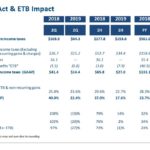 Source: BR – Q2 and 1H FY2019 Earnings Presentation – February 7, 2019
Source: BR – Q2 and 1H FY2019 Earnings Presentation – February 7, 2019
2nd Half 2019 Guidance
The rate of SG&A growth will moderate significantly with full year growth in the range of 3% – 5% which should enable BR to deliver its target of 70 bps of margin expansion FY2019.
Source: BR – Q2 and 1H FY2019 Earnings Presentation – February 7, 2019
BR closed the first half of FY2019 in line with its forecast and it has now reaffirmed FY2019 guidance and provided Q3 guidance.
Source: BR – Q2 and 1H FY2019 Earnings Presentation – February 7, 2019
BR’s growth objectives and its ability to have met/exceeded its objectives subsequent to having become a publicly traded company in 2007 gives me confidence that BR will continue to increase in value over the next few years.
Credit Ratings
There has been no change to BR’s credit ratings from Moody’s and S&P Global subsequent to my last article and the credit ratings are not under review.
Moody’s continues to rate BR’s long-term debt as Baa1 which is classified as lower medium grade. Standard & Poor’s continues to rate the debt BBB+ which is also lower medium grade.
These ratings are satisfactory for my purposes.
Free Cash Flow (FCF) Conversion
BR’s FCF levels in 2012 – 2018 were $0.244B, $0.22B, $0.334B, $0.365B, $0.362B, $0.402B, and $0.596B.
The projected FCF range for FY2019 remains unchanged at $0.565B -$0.615B.
Dividend, Dividend Yield, and Dividend Payout Ratio
On August 6, 2018 BR’s Board of Directors declared a quarterly dividend of $0.485/share ($1.46/year increased to $1.94/year) payable on October 3, 2018 to shareholders of record on September 18, 2018; I certainly do not expect BR to announce another 33% dividend increase in August.
On February 6, 2019 BR announced that its Board of Directors had declared a quarterly cash dividend of $0.485/share payable April 3, 2019 to stockholders of record at the close of business on March 15, 2019. This will mark the 3rd quarterly payment at this level; BR does not keep the dividend history segment of its website current.
As I compose this article BR is trading at ~$95.80 which results in a ~2% dividend yield using the $1.94/year dividend. While superior to the dividend yield reflected in previous BR articles I still strongly suspect many investors will pass on BR because of its low dividend yield.
When I wrote my August 7th article, BR reported FY2018 Diluted EPS (GAAP) of $3.56 and Adjusted Diluted EPS (Non GAAP) of ~$4.19. At the time, BR was projecting Diluted EPS (GAAP) growth of 12% – 16% ($3.99 – $4.13) and projected Adjusted Diluted EPS (Non GAAP) of 9% – 13% ($3.88 – $4.02). When I used the mid-point of these estimates ($4.06 and $3.95), the new $1.94 annual dividend represented a dividend payout ratio of ~47.8% and ~49.1%. At the time I was of the opinion that BR would have no difficulty in servicing its dividend.
When BR released its Q1 results and reaffirmed FY2019 projections I expressed the opinion that BR will have no issue in being able to service, and continue to increase, its dividend. My opinion remains unchanged following the release of Q2 results.
The Diluted Weighted-average shares outstanding as at FYE 2014 – 2018 amounted to (in millions of shares) 124.1, 124, 121.6, 120.8, and 120.4. As at December 31, 2018 this level had dropped to 119.4.
Valuation
At the time of my August 7th article, I indicated that on the basis of FY2018 Diluted EPS (GAAP) and adjusted Diluted EPS (Non GAAP) of $3.56 and $4.19, investors could expect Diluted EPS (GAAP) of ~$3.99 – ~$4.13 and adjusted Diluted EPS (Non GAAP) of ~$4.57 – ~$4.73.
Using the August 7th $129.17 closing stock price I arrived at a forward diluted PE range of ~30.8 – ~36.3 and a forward adjusted diluted PE of ~27.3 – ~28.3. I viewed these levels as lofty and indicated I would refrain from acquiring additional shares until such time as BR’s valuation retraced to the low – mid 20s (based on Diluted EPS (GAAP) results).
At the time of my November 6th article, BR’s shares had retraced to ~$105. Using this share price and the reaffirmed guidance, BR’s forward PE was ~25.4 – ~26.3 while its forward adjusted PE was ~22.2 – ~22.98.
Guidance has been reaffirmed just been reaffirmed and using the current ~$95.80 share price we now get a forward PE range of ~23.2 – ~24 while its forward adjusted PE range is ~20.3 – ~20.96.
I view shares are attractively valued based on BR’s long-term growth prospects.
Final Thoughts
I continue to view BR’s long-term prospects as attractive.
Based on my analysis I have acquired an additional 100 shares for the ‘side accounts’ within the FFJ Portfolio at $95.1899. This brings the total number of BR shares I am prepared to disclose to 501 shares; additional shares are held in undisclosed accounts.
I wish you much success on your journey to financial freedom.
Thanks for reading!
Note: I sincerely appreciate the time you took to read this article. Please send any feedback, corrections, or questions to charles@financialfreedomisajourney.com.
Disclaimer: I have no knowledge of your individual circumstances and am not providing individualized advice or recommendations. I encourage you not to make any investment decision without conducting your own research and due diligence. You should also consult your financial advisor about your specific situation.
Disclosure: I am long BR.
I wrote this article myself and it expresses my own opinions. I am not receiving compensation for it and have no business relationship with any company whose stock is mentioned in this article.


